Getting high: 15 of the best adrenaline activities
Our pursuit of new highs has spawned a glut of adventure activities. From horse boarding to storm chasing, we round up our favourites.
Cavemen didn’t need to chase hurricanes or go bungee jumping. Their daily quest for survival – in an age where danger lurked around every rock – provided them with all the adrenaline they needed.
By contrast, modern Homo sapiens – with their smartphones, desk jobs and supermarket loyalty cards – are left somewhat wanting when it comes to adrenaline. Life is much safer, yes, but it’s also decidedly duller.
Which is why the demand for adventure holidays and extreme sports is booming – we need to feel alive again and that’s best done by flirting with danger. There are plenty of adrenaline activities to choose from and here are 15 of the more unusual ones, which cater for all sensibilities:
1) Zero gravity, USA
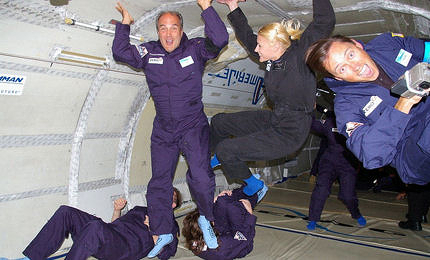 Experiencing weightlessness on board a zero gravity flight
Experiencing weightlessness on board a zero gravity flightCreative Commons / Steve Jurvetson
Nowadays, it’s not necessary to fly to space to experience weightlessness – zero gravity flights are available from locations across the USA. The experience is created during a series of quick ascents and descents, enabling passengers to feel weightless for up to 25 seconds. If you don’t like flying, forget it.
Fear factor: 5/5
2) Skywalk, China
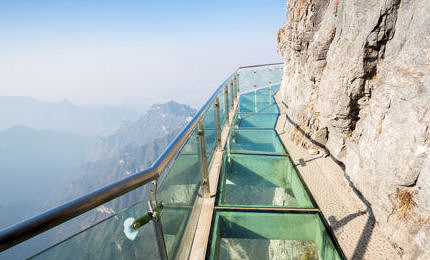 Don't look down during this mountain walk of faith
Don't look down during this mountain walk of faithVichie81 / Thinkstock
Known locally as the ‘walk of faith,’ this vertigo-inducing pathway is bolted to the side of Tianmen Mountain in Hunan, China. Perched some 1,219m (4,000ft) above a rocky ravine, the path is made of glass and has fantastic views of the canyon below.
Fear factor: 3/5
3) Storm chasing, USA
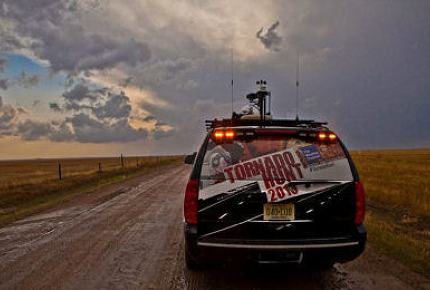 Storm Chasing Tours are growing in popularity across the US
Storm Chasing Tours are growing in popularity across the USCreative Commons / Anthony Quintano
Most residents living in ‘Tornado Alley’ flee their homes at the first sign of extreme weather. While they drive to safety, adrenaline junkies move in to flirt with the dangerous power of Mother Nature. Typically, storm chasing tours last six days and follow tornadoes as the whip up chaos across Texas, Oklahoma, Kansas and Nebraska. Some companies guarantee a storm or your money back.
Fear factor: 4/5
4) Stratosphere Skyjump, USA
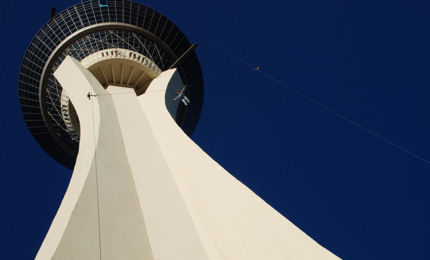 Free-falling from the Stratosphere hotel in Las Vegas
Free-falling from the Stratosphere hotel in Las VegasCreative Commons / Curtis and Renee
You know the saying – what happens in Vegas, stays in Vegas. But completing this 108-storey supported free fall, from the world’s tallest observation tower, might be a tale you want to tell when you get home. At 252m (829ft), though, the Stratosphere Skyjump is not for the fainthearted.
Fear factor: 4/5
5) SCAD Diving, Worldwide
The brainchild of an adrenaline junkie from Germany, SCAD diving is the only sport of its kind that offers an unattached free fall. Participants are hoisted up some 45m (150ft) on a crane and literally dropped into a safety net below. No training is necessary and there are no strings attached… literally.
Fear factor: 4/5
6) Rickshaw Run, India
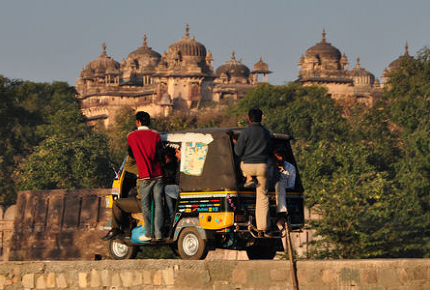 The Rickshaw Run is a 3,500 km journey through India
The Rickshaw Run is a 3,500 km journey through IndiaCreative Commons / Ricardo Hurtubia
This epic 3,500km (2,175 miles) rally tackles some of the most extreme roads in India. But, rather than using 4x4s, participants in the Rickshaw Run cram in auto-rickshaws, which have about as much power as a hairdryer. There is no set route, no support crew and no guarantee you’ll make it to the end. Still, it’s a lot of fun and all proceeds go to the Cool Earth charity, which aims to stop deforestation.
Fear factor: 3/5
7) Paramotoring, Worldwide
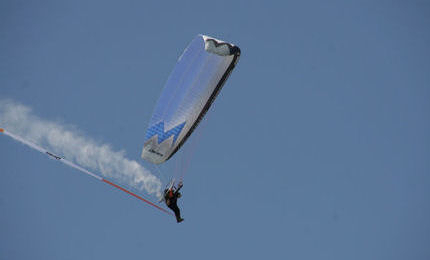 Paramotoring is surprisingly affordable and easy to learn
Paramotoring is surprisingly affordable and easy to learnCreative Commons / Les Chatfield
Like paragliding, but with a propeller strapped to your back, paramotoring is fairly easy to learn and doesn’t require much experience. The pilot wears a backpack complete with propeller, which thrusts them into the sky. With no runway needed, participants can take off from almost any open area.
Fear factor: 4/5
8) EdgeWalk, Canada
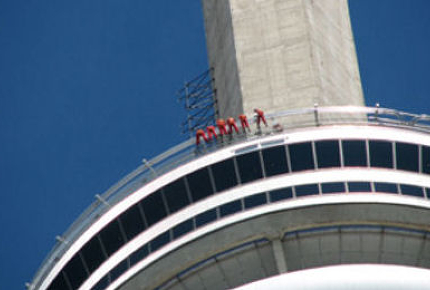 Daredevils dangle from the edge of Toronto's CN Tower
Daredevils dangle from the edge of Toronto's CN TowerCreative Commons / Ravenshoe Group
Live life on the edge at the CN Tower in Toronto, a 457m (1,500ft) communications tower which is home to the world’s highest full-circle, hands-free observation experience. Participants are attached to a harness via an overhead rail, which stops them falling onto the street below.
Fear factor: 4/5
9) Wing walking, Worldwide
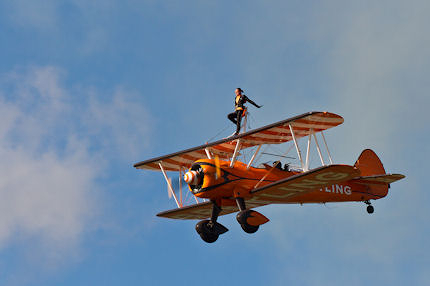 Testing balance on the wings of a plane
Testing balance on the wings of a planeCreative Commons / Marc Evans
Wartime pilots came up with the idea of wing walking to satisfy their appetite for danger. The concept took off and became popular at air shows, where pilots would try and attract the biggest audience with the riskiest stunt. Today, anyone can have a go – although it’s not for the fainthearted.
Fear factor: 4/5
10) Cage of Death, Australia
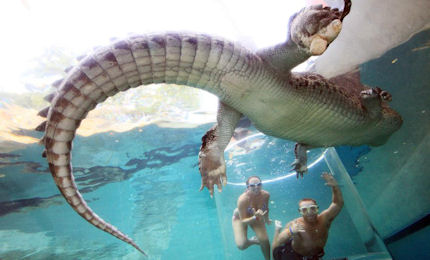 Getting up close and personal with Australia's crocs
Getting up close and personal with Australia's crocsCrocosaurus Cove
Flirt with the jaws of Australia’s most feared reptile at Crocosaurus Cove in Darwin, home to the infamous Cage of Death. There’s room for two in the glass cage, which is lowered into an aquarium containing some rather lively saltwater crocs.
Fear factor: 3/5
11) Dinner in the sky, Worldwide
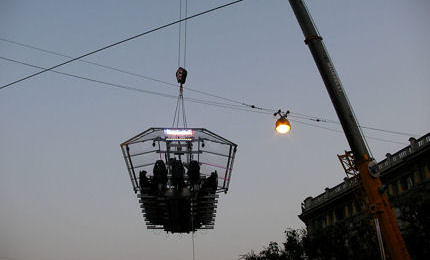 Enjoying dinner with a view from above
Enjoying dinner with a view from aboveCreative Commons / Bruno Cardioli
Careful how much wine you have at this dinner – you really don’t want to fall off your chair here. That’s because this luxury dining table is suspended 30m (100ft) above the streets, and gastronomes can quaff a meal while watching the world go by below. Organised by Dinner in the Sky, the dining experience is available in over 45 countries worldwide, and other themes put on by the company have included a Beach Bar in the Sky and an Opera in the Sky.
Fear factor: 2/5
12) Horseboarding, UK
Invented by a group of thrill-seeking horse trainers, the equine folly of horseboarding has developed into a bonafide sport in the UK. Participants can enter championships or have a quick go in fields across the country. Simply jump on a board, hold onto a rope and feel the speed as your steed starts galloping.
Fear factor: 3/5
13) 100mph zip line, UK
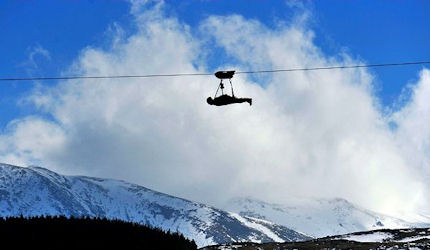 Reaching speeds of 100mph on the world's longest zipline
Reaching speeds of 100mph on the world's longest ziplineZip World
Opened last year, Zip World in Snowdonia is home to Europe’s longest zip line which also happens to be the world’s fastest. Suspended some 152m (498ft) above Penrhyn Quarry in Wales, an adrenaline rush is guaranteed as you reach terrifying speeds of 100mph (160km).
Fear factor: 4/5
14) Space flight, USA
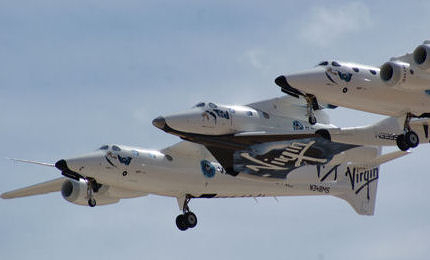 Travel to space on a Virgin Galactic flight
Travel to space on a Virgin Galactic flightCreative Commons / Jeff Foust
Virgin Galactic is offering the trip of a lifetime with flights to space. Scheduled for take off later this year, its fleet of suborbital spacecraft will reach speeds of up to 2,000mph (4,200km) and altitudes of 15,200m (50,000ft). The 2.5 hour suborbital trip will take off from New Mexico and tickets start at $250,000.
Fear factor: 5/5
15) Toboggan run, UK
A quick thrill, but a thrill nonetheless, the Chatham Ski Slope near London is home to the longest Cresta Run in the UK. No snow is required to toboggan down this 700m (2,297ft) tree-lined course, which is suitable for adults and children.
Fear factor: 2/5
-------------------------------------------------------------------------------------
Enjoyed this? Why not check out some of our other articles, including:
When travel goes wrong: alone on the Salar de Uyuni salt flats
Top 20 wonders of the underwater world
The 10 weirdest restaurants in the world
-------------------------------------------------------------------------------------
Do you have any Feedback about this page?
© 2025 Columbus Travel Media Ltd. All rights reserved. No part of this site may be reproduced without our written permission, click here for information on Columbus Content Solutions.









 You know where
You know where